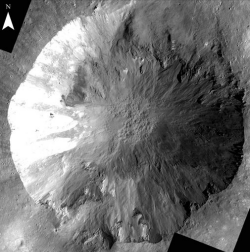 |
|

Craft spies interesting gullies on asteroid Vesta
[December 08, 2012]
PASADENA, Calif. (AP)
--
|
NASA's Dawn spacecraft spied two types of channels on the crater walls of the second-largest object in the asteroid belt. The first kind -- short and straight -- were likely carved by dry material flowing down the depression. But researchers are stumped by the appearance of long and narrow gullies. Such features are sculpted by water on Earth, but how they occurred on Vesta is not yet known. The new images were released Thursday at a meeting of the American Geophysical Union in San Francisco. Dawn departed from Vesta in September after a year of study and is headed toward Ceres, the asteroid belt's biggest object. It's scheduled to arrive in 2015. |



